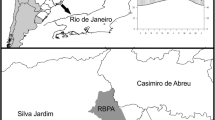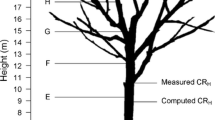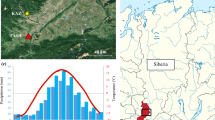Abstract
Long-term variation in tree-ring widths (1873–2006) and intra-annual dynamics of cambial activity and tree-ring formation in 2006 were studied in mature beech (Fagus sylvatica L.) trees at a typical forest site near Ljubljana (46°N, 14°40′E, 400 m a.s.l.) and related to leaf phenology and climate data. Tree-ring widths were negatively affected by minimum March and maximum August temperatures and favoured by May and July precipitation. Precipitation of the previous August and temperature of the previous November also had a positive effect. Leaf unfolding was affected by March and April temperatures, occurring later if they were low. Leaf yellowing was positively affected by minimum July temperatures and negatively by September precipitation. In 2006, leaf unfolding occurred on 16 April and was immediately followed by reactivation of cambium at breast height of the trees. One week later, the cambium obtained its maximum width (around 11 cell layers) and the rate of division increased until the end of May/beginning of June. By the end of June, 75% of the tree-ring was formed. Cambial cell divisions stopped from the end of July to mid-August. The average time of cambial activity was 100 days. Leaf yellowing occurred at the end of October, i.e. nearly 2 months after the cessation of cambial cell division. We discuss the usefulness of a combination of long-term (tree-ring width and phenology) and short-term (wood formation at a cellular level) data to understand better the environmental signals registered by a tree during growth.








Similar content being viewed by others
References
Antonova GF, Stasova VV (1993) Effects of environmental factors on wood formation in Scots pine stems. Trees 7(4):214–219
Baillie MGL, Pilcher JR (1973) A simple cross-dating program for tree-ring research. Tree Ring Bull 33:7–14
Bergant K, Kajfež-Bogataj L (2005) N-PLS regression as empirical downscaling tool in climate change studies. Theor Appl Climatol 81:11–23
Biondi F (1992) Development of a tree-ring network for the Italian Peninsula. Tree Ring Bull 52:15–29
Biondi F, Waikul K (2004) DENDROCLIM2002: a C++ program for statistical calibration of climate signals in tree-ring chronologies. Comput Geosci 30:303–311
Bončina A, Diaci J, Gašperšič F (2003) Long-term changes in tree species composition in the Dinaric mountain forests of Slovenia. For Chron 79:227–232
Bosshard HH (1974) Holzkunde, vol 2. Birkhäuser, Basel, pp 34–71
Bouriaud O, Breda N, Le Moguedec G, Nepveu G (2004) Modelling variability of wood density in beech as affected by ring age, radial growth and climate. Trees 18:264–276. doi:10.1007/s00468-003-0303-x
Brus R (2005) Dendrologija za gozdarje (Dendrology for foresters). Biotechnical Faculty, Department of Forestry and Renewable Resources, Ljubljana
Cook ER, Peters K (1997) Calculating unbiased tree-ring indices for the study of climatic and environmental change. Holocene 7:361–370
Črepinšek Z, Zrnec C (2005) Petinpetdeset let fenoloških opazovanj v Sloveniji, 1951–2005 (Fifty-five years of phenological observations in Slovenia, 1951–2005). Acta Agric Slov 85:283–297
Črepinšek Z, Kajfež-Bogataj L, Bergant K (2006) Modelling of weather variability effect on phytophenology. Ecol Modell 194:256–265
Deslauriers A, Morin H, Urbinati C, Carrer M (2003a) Daily weather response of balsam fir (Abies balsamea (L.) Mill.) stem radius increment from denrometer analysis in the boreal forest of Quebec (Canada). Trees 17:477–484. doi:10.1007/s00468-003-0260-4
Deslauriers A, Morin H, Begin Y (2003b) Cellular phenology of annual ring formation of Abies balsamea in the Quebec boreal forest (Canada). Can J For Res 33:190–200
De Luis M, Gričar J, Čufar K, Raventós J (2007) Seasonal dynamics of wood formation in Pinus halepensis from dry and semi-arid ecosystems in Spain. IAWA J 28:389–404
Diaci J (2007) Prilagajanje gojenja gozdov podnebnim spremembam (Adapting silviculture to climate change). In: Jurc M (ed) Podnebne spremembe: vpliv na gozd in gozdarstvo (Climate change: impact on forest and forestry). Studia Forestalia Slovenica 130, Ljubljana, pp 117–132
Di Filippo A, Biondi F, Čufar K, De Luis M, Grabner M, Maugeri M, Presutti Saba E, Schirone B, Piovesan G (2007) Bioclimatology of beech (Fagus sylvatica L.) in the Eastern Alps: spatial and altitudinal climatic signals identified through a tree-ring network. J Biogeogr 34:1873–1892. doi:10.1111/j.1365-2699.2007.01747.x
Dittmar C, Elling W (2006) Phenological phases of common beech (Fagus sylvatica L.) and their dependence on region and altitude in Southern Germany. Eur J Forest Res 125:181–188. doi:10.1007/s10342-005-0099-x
Dittmar C, Zech W, Elling W (2003) Growth variations of Common beech (Fagus sylvatica L.) under different climatic and environmental conditions in Europe-a dendroecological study. For Ecol Manage 173:63–78
Eckstein D (2004) Change in past environments—secrets of the tree hydrosystem. New Phytol 163:1–4. doi:10.1111/j.1469-8137.2004.01117.x
Eckstein D, Richter K, Aniol RW, Quiehl G (1984) Dendroklimatologische Untersuchungen zum Buchensterben im südwestlichen Vogelsberg. Forstwiss Cent 103:274–289
Eschrich W (1995) Funktionelle Pflanzenanatomie. Springer, Berlin
Fonti P, Solomonoff N, García-González I (2007) Earlywood vessels of Castanea sativa record temperature before their formation. New Phytol 173:562–570. doi:10.1111/j.1469-8137.2006.01945.x
Frankenstein C, Eckstein D, Schmitt U (2005) The onset of cambium activity—a matter of agreement? Dendrochronologia 23:57–68. doi:10.1016/j.dendro.2005.07.007
Geßler A, Keitel C, Kreuzwieser J, Matyssek R, Seiler W, Rennenberg H (2007) Potential risks for European beech (Fagus sylvatica L.) in a changing climate. Trees 21:1–11. doi:10.1007/s00468-006-0107-x
Gindl W, Grabner M, Wimmer R (2000) The influence of temperature on latewood lignin content in treeline Norway spruce compared with maximum density and ring width. Trees 14:409–414
Gričar J (2007) Xylo- and phloemogenesis in silver fir (Abies alba Mill.) and Norway spruce (Picea abies (L.) Karst.). Slovenian Forestry Institute, Ljubljana
Gričar J, Čufar K, Oven P, Schmitt U (2005) Differentiation of terminal latewood tracheids in silver fir during autumn. Ann Bot 95:959–965. doi:10.1093/aob/mci112
Gričar J, Zupančič M, Čufar K, Oven P (2007) Wood formation in Norway spruce studied by pinning technique and intact tissue sampling method. Wood Res Slov 52:1–9
Guiot J (1991) The bootstrapped response function. Tree Ring Bull 51:39–41
Gutierrez E (1988) Dendroecological study of Fagus silvatica L. in the Montseny Mountains (Spain). Acta Oecol Oecol Plant 9:301–309
Holmes RL (1994) Dendrochronology program library user’s manual. Laboratory of Tree-Ring Research. University of Arizona, Tucson
Horacek P, Slezingerova J, Gandelova L (1999) Effects of environment on the xylogenesis of Norway spruce (Picea abies [L.] Karst.). In: Wimmer R, Vetter RE (eds) Tree-ring analysis. Biological, methodological and environmental aspects. CAB International, Oxford, pp 33–54
Jump AS, Peñuelas J (2006) Running to stand still: adaptation and the response of plants to rapid climate change. Ecol Lett 8:1010–1020. doi:10.1111/j.1461-0248.2005.00796.x
Lebourgeois F, Breda N, Ulrich E, Granier A (2005) Climate-tree-growth relationship of European beech (Fagus sylvatica L.) in the French Permanent Plot Network (RENECOFOR). Trees 19:385–401. doi:10.1007/s00468-004-0397-9
Marinček L (1987) Bukovi gozdovi na Slovenskem (Beech forests in Slovenia). Delavska enotnost, Ljubljana
Marion L, Gričar J, Oven P (2007) Wood formation in urban Norway maple trees studied by the micro-coring method. Dendrochronologia 25:97–102. doi:10.1016/j.dendro.2007.05.001
Mayer H (1984) Waldbau auf soziologisch-ökologischer Grundlage, 3 Aufl., Fischer, Stuttgart-New York
Panshin AJ, De Zeeuw C (1980) Textbook of wood technology, Fourth edn. McGraw-Hill, New York
Peñuelas J, Boada M (2003) A global change-induced biome shift in the Montseny mountains (NE Spain). Glob Change Biol 9:131–140
Piovesan G, Biondi F, Bernabei M, Di Filippo A, Schirone B (2005) Spatial and altitudinal bioclimatic zones of the Italian peninsula identified from a beech (Fagus sylvatica L.) tree-ring network. Acta Oecol 27:197–210. doi:10.1016/j.actao.2005.01.001
Rossi S, Deslauriers A, Morin H (2003) Application of the Gompertz equation for the study of xylem cell development. Dendrochronologia 21:33–39
Rossi S, Anfodillo T, Menardi R (2006a) Trephor: a new tool for sampling microcores from tree stems. IAWA J 27:89–97
Rossi S, Deslauriers A, Anfodillo T, Morin H, Saracino A, Motta R, Borghetti M (2006b) Conifers in cold environments synchronize maximum growth rate of tree-ring formation with day length. New Phytol 170:301–310. doi:10.1111/j.1469-8137.2006.01660.x
Rozas V (2001) Detecting the impact of climate and disturbances on tree-rings of Fagus sylvatica L. and Quercus robur L. in a lowland forest in Cantabria, Northern Spain. Ann For Sci 58:237–251
Sass U (1993) Die Gefäße der Buche als ökologische Variable—Bildanalytische Erfassung, Dendroklimatologische Prüfung, ökologische Bewertung. Dissertation, Universität Hamburg
Sass U, Eckstein D (1995) The variability of vessel size in beech (Fagus sylvatica L.) and its ecophysiological interpretation. Trees 9:247–252
Schmitt U, Möller R, Eckstein D (2000) Seasonal wood formation dynamics of beech (Fagus sylvatica L.) and black locust (Robinia pseudoacacia L.) as determined by the “pinning” technique. J Appl Bot 74:10–16
Schmitt U, Jalkanen R, Eckstein D (2004) Cambium dynamics of Pinus sylvestris and Betula spp. in the northern boreal forest in Finland. Silva Fenn 38:167–178
Skomarkova MV, Vaganov EA, Mund M, Knohl A, Linke P, Boerner A, Schulze ED (2006) Inter-annual and seasonal variability of radial growth, wood density and carbon isotope ratios in tree rings of beech (Fagus sylvatica) growing in Germany and Italy. Trees 20:571–586. doi:10.1007/s00468-006-0072-4
Suzuki M, Kiyotsugu Y, Suzuki H (1996) Phenological comparison of the onset of vessel formation between ring-porous and diffuse-porous deciduoud trees in a Japanese temperate forest. IAWA J 17:431–444
Tarp P, Helles F, Holten-Andersen P, Larsen JB, Strange N (2000) Modelling near-natural silvicultural regimes for beech—an economic sensitivity analysis. For Ecol Manage 130:187–198
Werf van der GW, Sass-Klaassen U, Mohren GMJ (2007) The impact of the 2003 summer drought on the intra-annual growth pattern of beech (Fagus sylvatica L.) and oak (Quercus robur L.) on a dry site in the Netherlands. Dendrochronologia 25:103–112
Whitmore FW, Zahner R (1966) Development of the xylem ring in stems of young red pine trees. For Sci 12:198–210
Z’Graggen S (1992) Dendrohistometrisch- klimatologische Untersuchung an Buchen (Fagus sylvatica L.). Dissertation, University of Basel
Zeide B (1993) Analysis of growth equations. For Sci 39:591–616
Zeide B (2004) Intrinstic units in growth modelling. Ecol Modell 175:249–259
Acknowledgments
Climatic and phenological data originated from the Environmental Agency of the Republic of Slovenia within the Ministry of the Environment and Spatial Planning. We thank Prof. Dr. Lučka Kajfež-Bogataj for enabling us to use them. We thank Marko Beber, Martin Zupančič and Luka Krže for their work in the field and laboratory. The work was funded by the Ministry of Higher Education, Science and Technology of the Republic of Slovenia, Research Program “Lesarstvo”, and by the Spanish Ministry of Education and Science, project CGL2005-04270.
Author information
Authors and Affiliations
Corresponding author
Additional information
Communicated by H.G. Jones.
Rights and permissions
About this article
Cite this article
Čufar, K., Prislan, P., de Luis, M. et al. Tree-ring variation, wood formation and phenology of beech (Fagus sylvatica) from a representative site in Slovenia, SE Central Europe. Trees 22, 749–758 (2008). https://doi.org/10.1007/s00468-008-0235-6
Received:
Revised:
Accepted:
Published:
Issue Date:
DOI: https://doi.org/10.1007/s00468-008-0235-6




